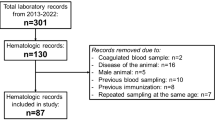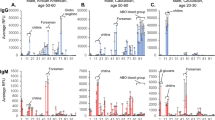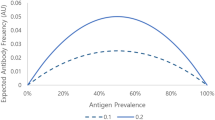Abstract
IN a preliminary communication eight sheep β-globulin types were described1. This number has now been increased partly by recognition of the fact that the two strongly staining zones C and D can be resolved into a third zone, and partly by the discovery of further types during examination of five hundred samples of sheep serum from Chelmsford abattoir.
This is a preview of subscription content, access via your institution
Access options
Subscribe to this journal
Receive 51 print issues and online access
$199.00 per year
only $3.90 per issue
Buy this article
- Purchase on Springer Link
- Instant access to full article PDF
Prices may be subject to local taxes which are calculated during checkout
Similar content being viewed by others
References
Ashton, G. C., Nature, 181, 849 (1958).
Ashton, G. C., Nature, 182, 370 (1958).
Ashton, G. C., and McDougall, E. I., Nature (in the press).
Author information
Authors and Affiliations
Rights and permissions
About this article
Cite this article
ASHTON, G. Further β-Globulin Phenotypes in Sheep. Nature 182, 1101–1102 (1958). https://doi.org/10.1038/1821101a0
Issue Date:
DOI: https://doi.org/10.1038/1821101a0
This article is cited by
-
Investigation of transferrin polymorphism in Garole sheep
Veterinary Research Communications (2010)
-
Blood Group Studies of the “Gene Bank” Sheep at Whipsnade Park
Nature (1967)
-
Transferrin Variation in Kangaroos
Nature (1964)
-
Occurrence of Two Plasma Albumins in the Domestic Fowl
Nature (1962)
-
An Unusual Bi-paternal Litter in Sheep from a Natural Double Mating
Nature (1962)
Comments
By submitting a comment you agree to abide by our Terms and Community Guidelines. If you find something abusive or that does not comply with our terms or guidelines please flag it as inappropriate.



